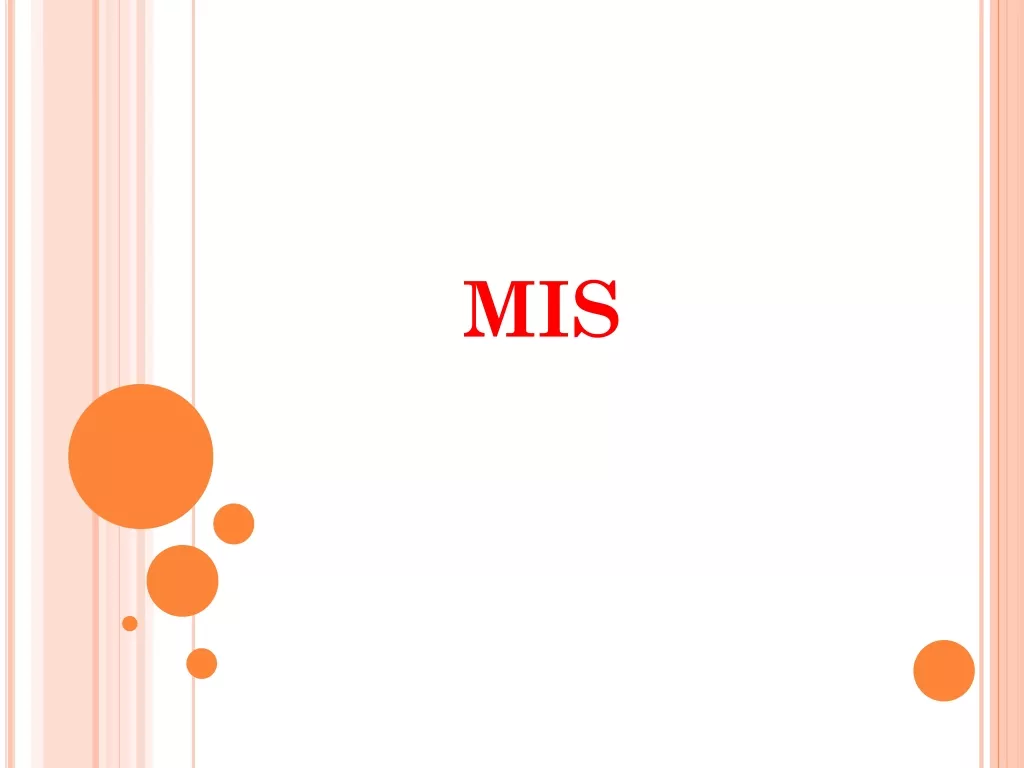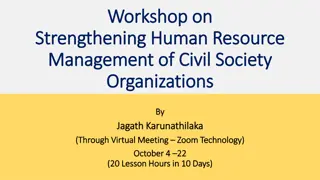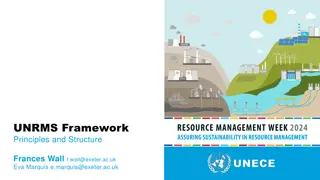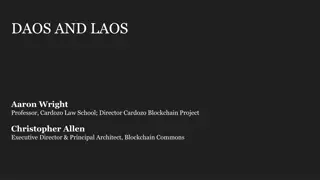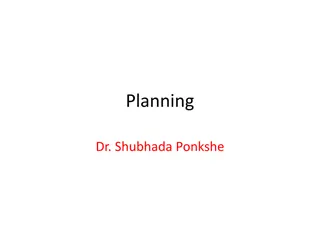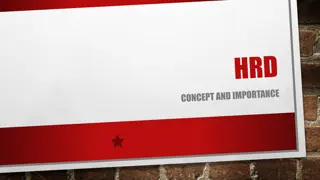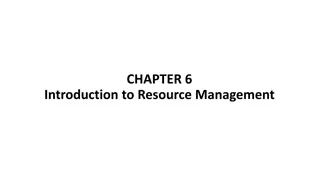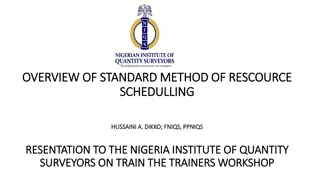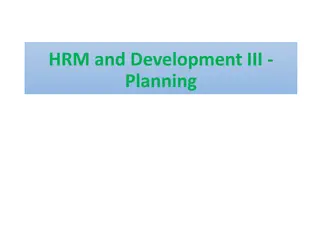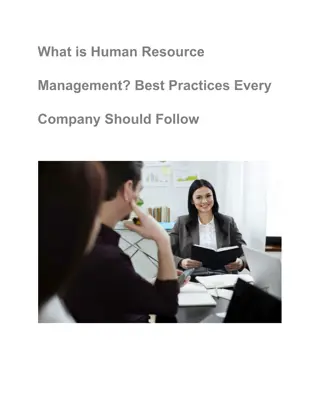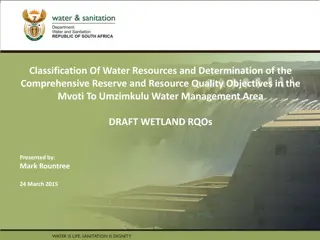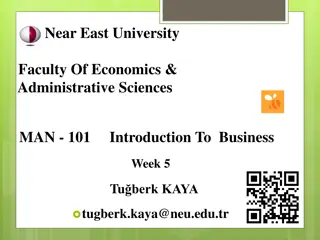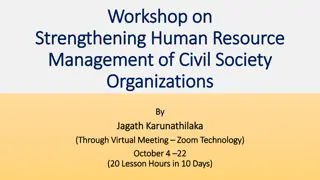Human Resource Management in Organizations
Human Resource Management entails managing an organization's workforce, focusing on attraction, training, assessment, and rewarding of employees, as well as ensuring compliance with employment laws. The function has evolved beyond transactional tasks to include strategic aspects like talent management and diversity. Discover the objectives, including maximizing job satisfaction, aligning individual and organizational goals, and enhancing employees' capabilities for optimal performance.
Uploaded on Feb 21, 2025 | 0 Views
Download Presentation

Please find below an Image/Link to download the presentation.
The content on the website is provided AS IS for your information and personal use only. It may not be sold, licensed, or shared on other websites without obtaining consent from the author.If you encounter any issues during the download, it is possible that the publisher has removed the file from their server.
You are allowed to download the files provided on this website for personal or commercial use, subject to the condition that they are used lawfully. All files are the property of their respective owners.
The content on the website is provided AS IS for your information and personal use only. It may not be sold, licensed, or shared on other websites without obtaining consent from the author.
E N D
Presentation Transcript
CMSE PREPARED BY ANJANA S LECTURER IN CIVIL ENGINEERING GPTC ADOOR
HUMAN RESOURCE MANAGEMENT It is the management of an organizations workforce,or human resources. It is responsible for attraction,selection,training,assessment,and rewarding of employees,overseeing organizational leadership and culture, and ensuring compliance with employment and labor laws. The function was initially dominated by transactional work such as payroll and benefits administration due to globalization, company consolidation, technological advancement and further research Human Resource focuses on merges and acquisitions, talent management, succession planning, industrial and labor relations, diversity and inclusion
OBJECTIVES OF HUMAN RESOURCE MANAGEMENT To help the organization reach its goals To ensure maximum utilization and maximum development f human resources To ensure respect for human beings To identify and satisfy the needs of individuals To ensure recolination of individual goals with those of the organization To achieve and maintain high morale among employees To provide organization with well trained and well motivated employees
To increase to the fullest the employees job satisfaction and self actualization To develop and maintain a quality of work life To be ethically and socially responsive to the needs of society To develop overall personality to each employee in its multidimensional aspect To enhance employees capabilities to perform the present job To equip employees with precision and clarity in transaction of business To indicate the sense of team spirit, team work and inter-team collaboration
Recruitment, Selection and Appointment Recruitment is the process of attracting interest and applications of vacant positions in an organizational structure It involves identifying the requirements to perform duties of a position, and advertising the position to attract suitable applicants Selection is the process of choosing the best person for vacant position It includes short listing of applicants for interview, developing questions for interview, interviewing applicants, selection on basis of merit.
Appointment covers the administrative processes to place and start the successful applicant. The purpose of this function is to attract, select and appoint experienced and qualified persons on basis of merit Merit of a person eligible for appointment to a position is determined according to nature of duties of position, the abilities, qualifications and experiences, standard of work performances relevant to those duties
Process Vacancy arises: it arises when an employee leaves an organization or a new position is established within the organizational structure Need to fill the position confirmed: when a vacancy arises ,the management reexamine the departmental structure to determine whether job redesign will be more efficient Review Job Description,Job Specifications,and Selection Criteria Prepare draft for Advertising(Internal and External):It includes brief description of duties,essential and desirable criteria etc Advertise: Vaccany positions must be advertised to enable suitably qualified persons to apply for position Application Forms: it will be only be accepted on organizations prescribed employment application form
Selection Committee: The composition of selection committee is the responsibility of the Human Resource Manager.Selection Committee consist of 3 representatives Shortlisting of Applicants Conducting Interviews Verifying Credentials Ranking Applicants Reference Checking Writing Selection Report Offers of appointment and starting salaries
EXTERNAL SOURCES OF RECRUITMENT Management consultants: 1. Management consultants are used for selecting higher level staff,act as a representative of employer 2. They make all necessary arrangements for recruitment and selection 3. They also take a service charge or commission Public Advertisements 1. Personal department of a company advertises vacancy in newspapers, internet etc 2. Advertisement gives information about company,job and required qualities of candidate 3. It is costly and time consuming
Campus recruitment: 1. Organization conducts interview in campuses of Management institutes and Engineering Colleges 2. Final year students who soon get graduate are interviewed 3. Suitable candidates are selected by organization based on academic record, communication skills,intelligence etc 4. This source is used for recruiting qualified,trained but inexperienced candidates
Recommendations 1. Organizations may also recruit candidates based on recommendations received from existing manager and sister companies Deputation Personnel 1. Organizations may also recruit candidates who are sent on deputation by Government or Financial institutions or subsidary companies
Employment exchanges 1. Government establishes public employment exchanges throughout the country. 2. These exchanges provide job information to job seekers and help employers in identifying suitable candidates. Labour Contractors 1. Manual workers can be recruited through contractors who maintain close contacts of such workers, this source is used to recruit labour for construction jobs
TRAINING OF EMPLOYEES It is the field which consists of organizational activity at bettering the performance of individuals, and groups in organizational settings It provides new skills for the employee It keeps the employee up to date with changes in the field It aims to improve efficiency It can be external or in house
MANAGING MEN Employees are the most important asset of the organization Quality and effectiveness of organization depends upon the quality of people employed Success of most organizations depends on employees with skills to perform tasks to attain company s strategic goals Management defines as that part of management which is concerned with people at work and their relationship within an organization
OBJECTIVES OF PERSONNEL MANAGEMENT It deals with optimum utilization of human resources within an organization It deals with creation of conditions in which each employee is encouraged to make his best contribution to effective working of the undertaking It deals with development of mutual respect and trust between management and workers through sound relations It encourages increase in productive efficiency to workers through training,guidance and counseling and tries to raise the morale of the employee
LABOUR WELFARE It is done for comfort and improvement of employees and is provided over and above wages Welfare keeps morale and motivation of employees high to retain employees for longer duration Welfare measures are not in terms but in forms Employee welfare includes monitoring of working conditions,creation of industrial harmony by infrastructure for health,industry retains,insurance against disease,accident and unemployment of workers and their families Labour sector addresses socio-economic aspects affecting labour welfare,productivity,living standards of labour force and social security Provides adequate labour force of appropriate skills
TRADE UNION / LABOUR UNION It is an organization of workers who have banded together to achieve common goals such as protecting the integrity of its trade, achieving higher pay, increasing number of employees, better working conditions Trade union through its leadership bargains with the employer on behalf of union members, and negotiates labour contracts with employers The main aim of this organization is to maintain or improve the conditions of their employment
This may include negotiation of wages, work rules, complaint procedures, rules governing hiring, firing, and promotion of workers, benefits, workspace safety and policies Agreement negotiated by a union are binding on the rank,and file members and employer and in some cases on other non member workers Trade unions have a constitution which details the governance of bargaining unit,and have governance at various levels of government depending on industry
STORES Materials are purchased only for works in progress and no reserve of stock should be kept with special sanction Organization of stores is necessary when: 1. Worksite is far way from place of material availability 2. Materials required are scarce in nature 3. It becomes difficult to get the materials or tools and plant to the site when actually required due to climatic conditions 4. Progress of work is very much affected for little amount of delay in supplying material or equipment
Divisional officer is responsible for proper arrangements made throughout his division for 1. Procurement of stores 2. Their custody and distribution according to requirement of works 3. Their disposal when rendered surplus or unserviceable Stores includes issueable articles,articles of dead stock of the nature of the plant,machinery,instruments,equipments,fixtures etc
Classification of Stores 1. Stock or General stores 2. Tools and plants 3. Road metal 4. Materials charged direct to works
STOCK Common use materials in construction work such as steelrods, cement, joist, AC sheets etc are kept in stock and issued when required for execution of work Advantages of keeping a stock for such articles are:- 1. Procurement ( ) of same item is not repeated for different works 2. Delay in the progress of the work can be avoided 3. Use of approved materials of the prescribed specifications is ensured
Unnecessary accumulation of material may 1. Cause deterioration in storage 2. Increase the capital investment cost 3. Result in increased costs of shortage and handling Maximum amount of materials kept in a stock in a division is fixed and known as Reserve Stock Limit This limit is fixed by government, keeping into consideration the normal requirements of stock If construction work in a division increases substantially over the normal activity, a temporary reserve limit may be sanctioned for extra activity
Receipt of materials on stock Materials are received on stock from the following sources: 1. Suppliers or contractors: Most supplies are procured by direct purchase from suppliers and contractors 2. Other sub-divisions, divisions, and departments: Supplies are obtained from these sources when available materials exceed their requirements 3. Public Work Central Stores: Some of the items required for execution of works may not be available in subdivision, stock may be obtained from central stores 4. Department manufacture: Some of the stock items may be received from departmental manufacturing units 5. Works/Buildings:Some items may be obtained by recoveries from works/buildings that are dismantled
Record of receipt of stock All materials received must be examined ,weighed, counted or measured Record of detailed measurement is kept in M-Book and total number of quantity received should be entered in Register of stock receipts Records can be treated as very important records Bincards are made where the material is stored and contains date wise record of receipts, issues and balances of each item of stock Detailed information about stock position withdrawl,rate,the time when purchase order is to be placed is entered in bincard Bincard is tagged to each item of stock giving details of reciept,issues and balances on any day
HEAVY PLANT AND MACHINERY Proper selection of heavy plant and industry enables construction more speedy and economical Problem of selecting most suitable plant and machinery for any construction project is an important task and its planning is a highly technical job The aim is to increase production ,simplify operations,and reduce maintenance Contractor may not afford to have all types or sizes of equipment which are required for execution of his works,the nature of the project, cost of the equipment
MATERIALS HANDLING It is a technique to move, transport,store or distribute materials with or without mechanical appliances Due to several complexities in construction process,managers ad engineers must be aware of material handling techniques hence unit cost of construction can be cut down All material handling and storage activities should be planned to obtained maximum overall operating efficiency The main objective of planning material movement should be to save money,time,and men
TRANSPORT VEHICLES AND INSPECTION OF VEHICLES Mobility accounts for unevenness in distribution of goods and other construction materials which have to be moved from surplus areas to scarcity Construction manager is responsible for arrangement maintainances and inspection of vehicles so that construction activity is carried out without wastage of time and money Mechanically propelled vehicles are driven by trained and competent persons
TOOLS AND PLANTS The machinery,equipment,vehicles,and instrument required for use as tools and plants Tools and plants are classified into:- 1. Generally or ordinary tools and plants: These are required for general use in the divison 2. Specially machinery and equipment: These are required for general use in the divison and procured for use in specific works Cost of general tools and plants is charged to minor head tools and plants and cost of special machinery is charged to work concerned
Materials at site account(MAS account) In case of minor works,not for heavy transactions,an account in form PWD VI-83 should be maintained for all department materials brought on a site of a work Detailed account of material issued to the work is called as materials at- site account All department materials should be brought on site of work for use on that work ,from any source should be entered as receipts in Material at-site-accounts on a receipts giving reference to measurement book
The register of material-at-site account should show separately for each material: 1. The estimated requirement 2. The issue rate 3. Reciepts, issues and balances month to month 4. Net issues at the end of each month After completion,theoritucal calculation of quantities of materials is based on the magnitude of work executed These are recorded in part I and partII indicating surplus or deficit as per actual consumptions and theoretical calculations Part III shows disposal of material remaining used the unused material is disposed in the following: 1. Transfer to stock,provided the items are serviceable and likely to be required for other works 2. Transfer to other works in progress 3. Sale of the items that are no longer required or not fit for use
Borrowing and lending of tools and plants In cases where contractor can either or for a department to take all tools and plants required due to lack of finance, in such cases tools and plants are borrowed from hire basis from sources when they are available Department can supply them on hire basis to the contractors for completing the work Hire charges are worked out on capital cost,out turn of equipment,depreciation,useful life of machinery,maintainance cost and operational cost After completion on special tools and plants used or when the tools and plants no longer required for use thereon the divisional officer may transfer them
Safe custody of stores Divisional engineer is responsible for initial procurement its safe custody ,proper storage,distribution and disposal of surplus stores In PWD the stores is held by section officer and he is responsible to divisional engineer for safe custody and proper distribution ,accounting and submission of reports and return Materials received are expected to be stored in stores building Materials or equipment received are first checked against orders and entered in M-book by section officer,materials are handed over to the store Store keeper maintains proper record of receipts and issues
Central stores It is used in large projects as a ready sources for supplying common materials required for different type of works Advantages When projects are located in remote places time delay can be avoided for procuring and transporting required materials Delay in progress of work can be reduced by essential materials in central stores In case of non availability of materials or scarcity of materials at the required time,central stores issues materials at required time In future demand or rise in cost such materials are procured by government stores kept in reserve stock Various tools and plant,equipment and machinery may be procured and accounted by the central stores
Various machinery works in project becomes necessary to keep them in good condition,hence spare parts are procured from central stores Day to day maintainance ,to attend minor repairs a workshop is organized in central stores Explosives will be kept in central stores to avoid time delay in execution of works such material require liscence and other formalities reduces the progress of work
Procedure for taking delivery from station yards Manufacturers or suppliers of equipment and machinery will be send by trains After booking the equipment for dispatch, railway receipt is send to consignee to take delivery by submitting railway receipt to railway authorities The consignee presents railway recipt to the concerned railway station after signing the rear side of railway receipt Credit notes In government departments,freight charges for transport of material is paid through credit note in prescribed form Transactions adjusted by Accountant General
Indemnity bond Suppliers of equipment or materials send railway receipt by post to the concerned after booking the material with railways In case the railway recipt is delayed or lost in the transit the consignment is cleared by executing bond in favour of railways The bond is to be executed by consignee called indemnity bond
Wharfage and Demurrage charges If the consignments are not taken from station yard within a stipulated period from the time the consignment is available for delivery the railway department penalty called wharfage charges If a wagon of materials for a consignee is not cleared within 6 hours of day light period from the time the wagon is ready for unloading the railway charges penalty called demurrage charges
ISSUE OF MATERIALS Issue of materials from stock for the following purposes: 1. For use of works either by contractors or departmentally 2. For dispatch to other subdivisions or departments 3. For sale of contractors ,employees and outside parties
Issue of materials to contractors Items like cement ,steel,asphaltic materials are issued to cotractors by the government from stock The contractor should specify: 1. Full description of materials to be supplied by the government for use on the works 2. Place of delivery 3. Rate,including storage rate, to be charged to contractor for each iem 4. Contractor shall be responsible for obtaining items and making payment at the rate specified by deduction of bills 5. No carriage or incidental charges are borne by government beyond place of delivery
INDENTS Materials should be issued from stock only on the recipt of an indent ,form 7(PWD VI-II) signed by divisional or sectional officer Indents on stores are demands on store keeper signed by authorized persons to issue a bearer to charged to a particular job or department Indents contains date,necessary particularls of stores required such as quantity and description order or job number, signature of officer making it, intial of issuing store keeper, signature of person receiving the material Store keeper examine the indent and sign in space provided
INVOICE STOREKEEPER sign the invoice attached to indent according to supply An entry is made in the register of stock issues The indent is returned to indentending officer and signature of receiving officer is done Invoice is treated as voucher
Bincard This is a card attached to each rack,shelf or other container for stores A record of materials enetering or leaving bin and balance of materials in hand is kept in the card Cards are entered by storekeeper They should agree with quantities of material and should keep relevant account in store ledger which allows storekeeper to remind the fresh stock when minimum stock has reached Bincards are checked by inspecting officers with their initials on cards and note discrepancies
Unstamped receipt In PWD, unstamped receipts are used for acknowledgement of stores and materials issued to contractors While issuing contractors are duly signed no stamp is required when value of materials issued is more than Rs 500/- Recipts are taken in tripilicate,2 of them are sent to divisional office along with abstract of stock issues
Stock register Divisional office maintains day to day record of both quantity and Value of transactions relating to each item of stock Separate ledgers are maintained for each subhead Register has different section of pages for different articles When good received sheets are posted in the priced stores ledger Provision is also made for a monthly total of the value of receipts,issues,and balances of each item Pages of stock receipt and stock issues should be machine numbered and entries are checked by atleast 10% by divisional engineer
PERIODICAL INSPECTION OF STORES Executive engineers shall check all stocks once in a year All stores should be counted by an officer not below the rank of sub divisional officer All articles of stock(not tools and plants) are not required during following 12 months should be reported to executive engineer Verification should be done in presence of subordinate authority responsible for custody of stores If any discrepancies found during verification, should be brought to account immediately All unserviceable stores found during verification should be reported to the authority to write off the terms Balance of stores should not be held in excess of requirements for a reasonable period A certificate of verification of stores is done by verifying officer
Irregularities in stock account Items not recorded in bincards with entries of the indents Stock issued to contractors not recorded in contractor ledger Transactions not recorded at time of issue/receipt in the order of their occurrence Shortage or surplus not adjusted Corrections not initialed Transactions not duly supported by indents Issues not acknowledged by intender on the copy of intent is retained by stores in charge
Accounting of shortages or surplus In shortage or deficit, value of stores not to be debited on Miscellaneous PW Advance for pending recovery When loss is unrecoverable ,the head Miscellaneous PW Advance is cleared by debit to work for which stores were collected ,if accounts still open Values of stores found surplus should be credited as revenue receipt on concerned head of account
Loss of Stores All losses of stock should be investigated,necessary steps taken to obtain sanction of competent authority to write off In serious losses ,Divisional Engineer should conduct departmental enquiry, record the evidence, his findings and his conclusions as regards the responsibility and capacity of person An immediate report of loss of stores must be made to police,all steps for recovery of property When tools are lost by contractors or departmental employees, cost to be recovered should be replacement value includes book value of articles lost including storage charges and an addition of 10% to cover charges
Surplus stores All surplus stores divided into 1. Serviceable 2. Unserviceable Stores including tools and plant become unserviceable,a report made in survey report form All unserviceable articles should be sold in public action and sanction of competent authority All serviceable surplus materials at worksite ,if useful on otherworks shall be transferred to works in progress or brought on to stock account


